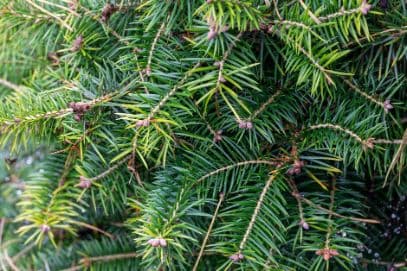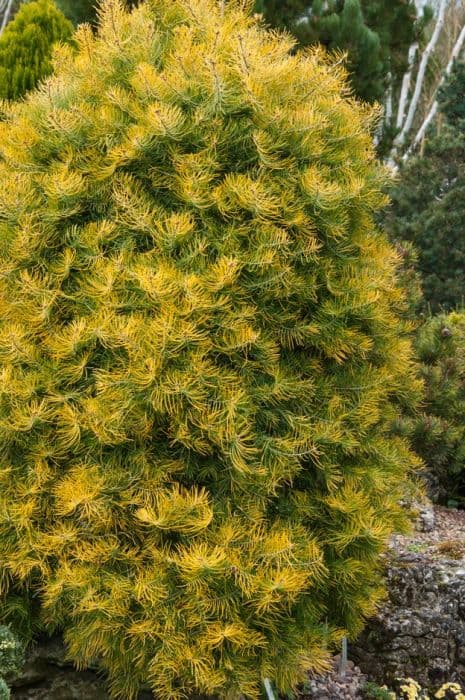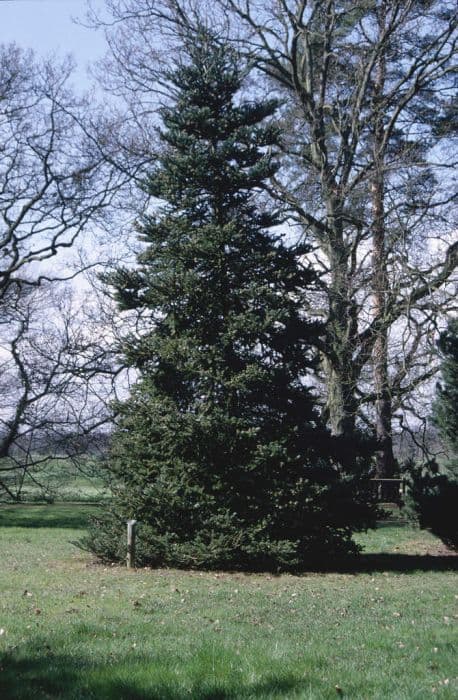Korean fir 'Kohout's Ice Breaker' Abies koreana 'Kohout's Ice Breaker' (PBR)

ABOUT
'Kohout's Ice Breaker' is a dwarf conifer reaching to 60cm tall and wide after ten years in cultivation. It initially has a globose form but eventually develops into a small, squat tree. The recurved needles showing the white undersides of the leaves give the plant a silvery-blue appearance
About this plant
 Names
NamesSynonyms
Kohout's Ice Breaker Korean Fir, Ice Breaker Korean Fir.
Common names
Abies koreana 'Kohout's Ice Breaker' (PBR)
 Characteristics
CharacteristicsLife cycle
Perennials
Foliage type
Evergreen
Color of leaves
Blue-green
Height
1-2 feet (30-60 cm)
Spread
2-3 feet (60-90 cm)
Plant type
Tree
Hardiness zones
5
Native area
Korea
Benefits
 General Benefits
General Benefits- Compact Size: Ideal for small gardens due to its slow-growing and compact habit.
- Ornamental Appeal: Features unique curled needles that are silver-blue, adding year-round visual interest.
- Low Maintenance: Requires minimal care once established, making it suitable for gardeners of all skill levels.
- Drought Tolerance: Once established, it is relatively drought-resistant, reducing the need for frequent watering.
- Resistant to Deer: Less likely to be damaged by deer browsing, which can be beneficial in areas with a large deer population.
- Cold Hardy: Can withstand cold temperatures, making it suitable for growing in a range of climates.
- Evergreen Foliage: Provides color and structure throughout the year, even in the winter months.
- Attracts Wildlife: The cones may attract birds, adding an element of wildlife interest to the garden.
- Landscape Versatility: Can be used in a variety of landscaping designs, including rock gardens, as a specimen plant, or in containers.
- Seasonal Interest: Produces decorative cones that further enhance its aesthetic appeal during different seasons.
 Medical Properties
Medical PropertiesThis plant is not used for medical purposes.
 Air-purifying Qualities
Air-purifying QualitiesThis plant is not specifically known for air purifying qualities.
 Other Uses
Other Uses- The slow-growing nature of 'Kohout's Ice Breaker' Korean fir makes it a suitable candidate for bonsai cultivation, where enthusiasts can train and prune it into miniature landscapes.
- Korean fir's dense growth habit can be used for creating privacy screens in small garden spaces or urban environments.
- The unique curled needles of 'Kohout's Ice Breaker' can be studied as a biological example of needle adaptation in botany education.
- Due to its ornamental value, branches of Korean fir can be cut and used for decorative purposes in floral arrangements and wreaths, especially during the holiday season.
- The resin of Korean firs can be collected and used as a natural adhesive or to waterproof small objects, although this is more common in wild types and not specifically cultivated cultivars like 'Kohout's Ice Breaker'.
- The tree can be planted in theme gardens, such as a winter-themed area, due to its frosty appearance provided by the whitish coloration of the needles.
- Photographers and painters might use 'Kohout's Ice Breaker' as a subject for its unique aesthetic and textural qualities, adding depth and interest to artistic compositions.
- Korean fir can be used in sensory gardens, where its textured foliage is appealing to touch, providing a tactile experience for visitors.
- The wood of Korean fir, although not commonly used due to the small size and ornamental nature of 'Kohout's Ice Breaker', can sometimes be utilized in specialized woodworking projects or in crafting small wooden objects.
- The neat and compact form of 'Kohout's Ice Breaker' could be incorporated into garden designs for urban spaces where greenery is needed without taking up much space.
Interesting Facts
 Feng Shui
Feng ShuiThe Korean Fir is not used in Feng Shui practice.
 Zodiac Sign Compitability
Zodiac Sign CompitabilityThe Korean Fir is not used in astrology practice.
 Plant Symbolism
Plant Symbolism- Endurance and Strength: As a type of fir tree, Abies koreana, commonly known as Korean Fir, often symbolizes endurance and strength due to its ability to survive in harsh climates and on difficult terrain.
- Resilience: Similar to endurance, the Korean Fir's ability to withstand cold temperatures and grow in challenging conditions signifies resilience against adversity.
- Purity and Cleanliness: The crisp, fresh nature of fir trees, with their evergreen leaves, suggests purity and cleanliness.
- Hope: Evergreens like the Korean Fir are often associated with hope because they retain their leaves throughout winter, suggesting the promise of spring and renewal.
- Peace: Evergreens have been used traditionally to symbolize peace, and Korean Fir's soothing presence in a landscape underscores this symbolism.
 Water
WaterThe Korean Fir 'Kohout's Ice Breaker' should be watered deeply and less frequently to encourage strong root growth. During the first growing season, water it thoroughly once a week, providing approximately 1 to 1.5 gallons each time, depending on the soil moisture and weather conditions. Once established, frequency should be reduced, and the plant should be watered every two to three weeks, with increased amounts during hot, dry spells. The goal is to maintain evenly moist soil, as Korean Fir does not tolerate drought well but also is sensitive to waterlogged conditions.
 Light
LightKorean Fir 'Kohout's Ice Breaker' thrives in full sun to partial shade. The ideal spot for this plant is one where it receives at least four to six hours of direct sunlight daily, with some protection from the intense afternoon sun in hotter climates. Dappled or afternoon shade can help prevent scorching of its delicate foliage during peak summer heat.
 Temperature
TemperatureThe Korean Fir 'Kohout's Ice Breaker' is hardy and can withstand winter temperatures as low as -20 degrees Fahrenheit. It grows best in cooler climates, with ideal temperatures ranging between 60 and 75 degrees Fahrenheit. This plant can tolerate cold down to about -20 degrees Fahrenheit but may struggle in areas where summer temperatures consistently exceed 80 degrees Fahrenheit.
 Pruning
PruningPruning for Korean Fir 'Kohout's Ice Breaker' is generally to shape the plant or remove any damaged or diseased branches. Prune in late winter or early spring before new growth begins. It doesn’t require frequent pruning; do so only as needed to maintain its shape or to remove the occasional broken branch.
 Cleaning
CleaningAs needed
 Soil
SoilKorean Fir 'Kohout's Ice Breaker' thrives in well-draining, moist soil with a high organic matter content. The best soil mix includes equal parts of loamy soil, peat, and perlite or coarse sand to ensure proper drainage. Aim for a slightly acidic to neutral pH, between 5.5 and 7.0.
 Repotting
RepottingKorean Fir 'Kohout's Ice Breaker', being a slow-growing conifer, doesn't require frequent repotting. It should only be repotted every 3-5 years or when it has clearly outgrown its current container.
 Humidity & Misting
Humidity & MistingKorean Fir 'Kohout's Ice Breaker' prefers moderate humidity levels and can usually tolerate the natural outdoor humidity in its growing zones. It doesn't have specific humidity requirements but should not be in an overly dry environment.
 Suitable locations
Suitable locationsIndoor
Provide bright light, cool temps, and avoid dry air.
Outdoor
Plant in well-draining soil; full sun to partial shade.
Hardiness zone
5-7 USDA
 Life cycle
Life cycleAbies koreana 'Kohout's Ice Breaker', commonly known as Korean Fir 'Kohout's Ice Breaker', begins its life cycle when the mature trees produce cones, typically in spring. The cones release seeds that, if conditions are right, germinate to produce small seedlings. These seedlings grow into juvenile plants, gradually developing the characteristic dense, compact habit and curled needles that define this cultivar. As the Korean Fir 'Kohout's Ice Breaker' matures, it gains the ability to withstand colder temperatures and establishes a strong root system. Over the years, the plant will reach its mature size and shape, usually staying relatively dwarf compared to other fir species. The mature Korean Fir 'Kohout's Ice Breaker' will then produce its own cones, continuing the reproductive cycle.
 Propogation
PropogationPropogation time
Early Spring
The most popular method for propagating the Korean Fir, known as 'Kohout's Ice Breaker', is through grafting. This technique is typically performed during the dormant season, usually in late winter to early spring. Grafting involves taking a cutting or scion from a mature Korean Fir and attaching it to the rootstock of another fir species. The cut surfaces are aligned and bound together, often with grafting tape, to encourage the tissues to fuse. Over time, the scion grows and forms a new tree genetically identical to the 'Kohout's Ice Breaker', benefiting from the rootstock's established root system for better growth and vigor.









